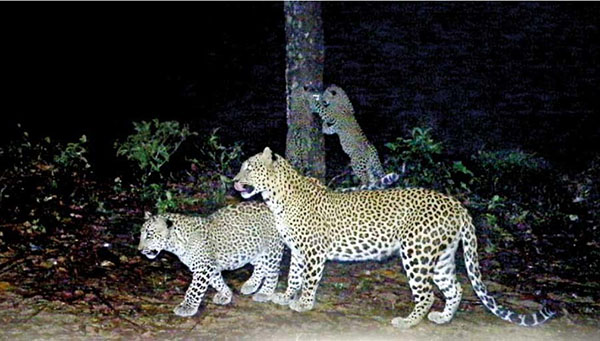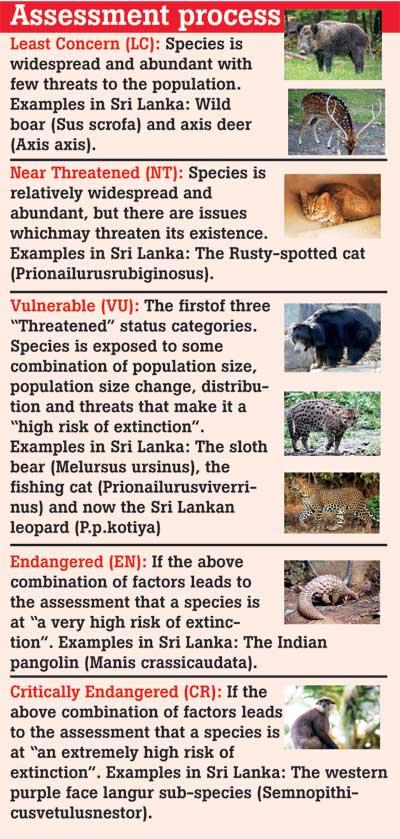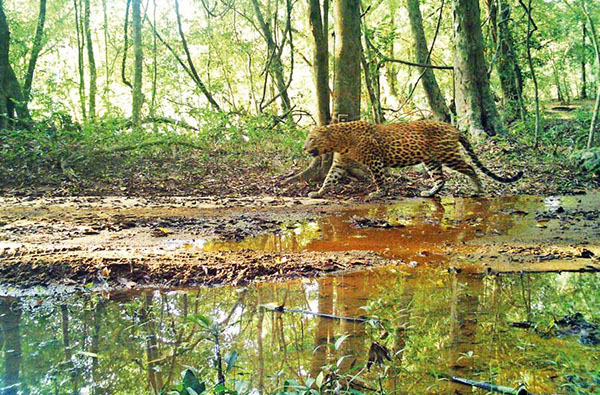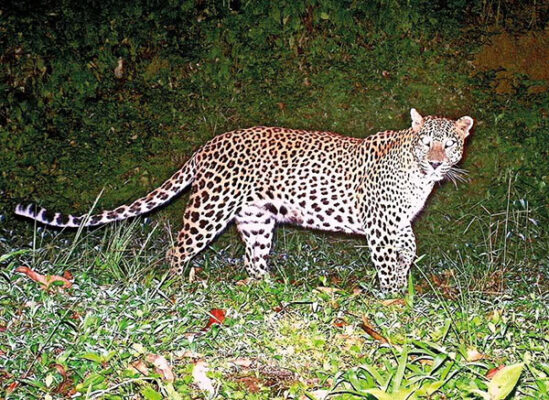Endangered no more… ‘Vulnerable leopards’ treading with caution!-by Andrew Kittle & Anjali watson

A female leoaprd with her two cubs in Central Highlands
Source:Dailymirror
- The Sri Lankan leopard remains listed as locally Endangered under the IUCN country Red List
- It is a priority species commanded full protection under the Fauna and Flora Protection Ordinance (1938)
- We need to ensure better on ground protection for what is one of the last island leopard populations that continues to survive
- The Sri Lankan leopard subspecies (Panthera pardus kotiya) is down listed on the International IUCN Red List of Species

In light of the recent leopard deaths (11) this year, including that of a black leopard and other snaring
incidents which grabbed much media attention and created a public outcry, this status change of the Sri Lankan leopard may come as a surprise to many. However, there is much more that needs probing when assessing an overall species status and probability of its long-term survival. Hence, this is cautionary good news that we report, but with a warning that a close watch needs to be kept on this island leopard population and the threats it faces, as it could easily slip back into endangered status, especially given the precarious position as which it still sits.
In 2020 the status of the Sri Lankan leopard (Panthera pardus kotiya) has just been down-listed from Endangered (EN) to Vulnerable (VU) on the International Union for the Conservation of Nature’s (IUCN) Global Red List of Threatened Species (www.iucnredlist.org). As the IUCN assessors for this endemic sub-species we want to shed some light onto the down-listing process and how it affects the leopard in Sri Lanka.
Assessment process
The IUCN Red List is the world’s most definitive estimate of the status of a species, compiled using all available distribution, abundance and threat data. Using this information and specified criteria, species are assigned a particular status which guides management and conservation strategies. The Red List status categories are as follows:
There are two additional categories – Data Deficient (DD), which indicates –insufficient data available to determine
status, and Not Evaluated (NE), meaning the species has not been evaluated against the IUCN criteria. There are multiple Red Lists, with the scope of assessments either global or country-by- country, so a species might be globally common, but very rare in a Sri Lanka, so that species’ global status might be “Least Concern” and Sri Lankan status “Endangered”.
Challenges
The biggest challenge of species status determination is getting the requisite data, as wild animals, particularly solitary, cryptic predators are not easy to count. Remote cameras have provided a useful way to document carnivore distribution and estimate populations but even with these, multiple studies are required in order to fill in as many blanks as possible across habitats until a broader, scientifically robust picture begins to emerge. This is how the Wilderness & Wildlife Conservation Trust (WWCT) under the purview of the Department of Wildlife Conservation (DWC), has approached things in Sri Lanka, moving around the country, eco-zone by eco-zone, using a standardised spatially-explicit remote camera survey method to estimate leopard populations in different areas in order to amalgamate data for a reasonable island-wide estimate used by the IUCN Red listing process.

“Threats to the leopard are a constant menace, as seen this year by rampant forest loss and a disconcerting number of snared animals”
There have been scientists engaged in understanding the ecology and behaviour of Sri Lanka’s leopards for decades, including the former Director of the National Museum P.E.P. Deraniyagala, who in 1956 first put forth the idea that the Sri Lankan leopard was a separate sub-species, a notion confirmed by Dr. Sriyanie Miththapala in 1989 using DNA analysis. The earliest known leopard population estimate comes from a hunter named Clark in 1901 who estimated that there were 1660 leopards in the country. In the 1960s Smithsonian Institution scientist John Eisenberg and student Nancy Muckenhirn estimated the leopard density in Wilpattu and in 1982, the late Professor Charles Santiapillai, one of Sri Lanka’s pre-eminent zoologists, estimated leopard density in Block I of Yala National Park. In 1994, Professor Mangala de Silva, and Yala National Park DWC officer B.V.R. Jayaratne followed up with another estimate of leopard population in Block I. Both of these estimates – as well as the Smithsonian Wilpattu estimate are very similar to our own results from these National Parks conducted in 2001-02 (Yala) and 2015 (Wilpattu).
In 1982 Dr. Santiapillai and company suggested that Sri Lanka held “fewer than 1000 leopards”, later clarified to be ~400 – 600 individuals. The assumption at that time was that leopards were almost exclusively restricted to the island’s National Parks and Reserves. Subsequent research by us has revealed that leopards occur more widely than previously assumed, residing outside Protected Areas including in buffer zones and small forest patches, from the Central Highlands to the lowland dry zone.
In 2008 we were tasked with conducting the updated IUCN status determination for Sri Lankan leopards. A better idea of the distribution of the species in the country and our 2002 statistically robust estimate of Yala National Park’s Block I population, allowed for a more nuanced estimation method. The final estimate was 834 mature individuals (range: 700 – 950) and since the overall population of mature individuals was < 2500, with an inferred population decline due to forest loss and human persecution, and the assumption that no sub-population was greater than 250 individuals, the sub-species status fell into the IUCN’s “Endangered” category.

Adult male Gal Oya NP
New assessment
In 2018, the IUCN asked for a re-assessment. In the intervening decade we had greatly improved our understanding of leopard ecology in Sri Lanka with robust population surveys completed in the montane zone (Horton Plains NP-2012), the lowland dry zone (Wilpattu NP-2015), and the unprotected Central Highlands tea estate landscapes (Maskeliya region – 2016). We also had new distribution data and a lot of remote camera capture rates throughout the island including protected areas of various types, and unprotected areas (e.g. Gal Oya NP, Ritigala Strict Natural Reserve, Namal Oya Sanctuary, Sigiriya private lands, sub-montane zone lands). The updated population estimate was therefore based on a lot of new information. Two other recent studies – in Wilpattu NP in 2018 by Dinal Samarasinghe and team and in Horton Plains NP in 2017-18 by Dr. Enoka Kudawithanegas’ team – did not have results available yet so were not included, and regardless their subsequent estimates were similar enough to our own previous ones. The updated population estimate was 776 mature individuals (range: 529 – 1132) and suggested a 7% population size decrease from 2008 to 2018, a rate of decrease not sufficient, according to IUCN criteria, for the species status to be considered Endangered. This is actually a positive outcome in that we are not seeing a large population decline, even outside the well-known protected areas.
“A suspected population decline comes from observations of increasing forest cover loss and increasing human persecution”
As a result, the status of the sub-species was changed from Endangered to Vulnerable, but because the new estimate was based on new data it is considered a “Non-genuine change” based on new information. We suggested within the assessment that this status change be carefully monitored as we suspect that threats are increasing and the population is likely to be decreasing. A suspected population decline comes from observations of increasing forest cover loss and increasing human persecution. Again, this means that the change of status for the Sri Lankan leopard, while a positive outcome overall, needs to be carefully monitored. The IUCN has agreed and the status change is marked as precautionary with the Sri Lankan leopard a sub-species “under observation” and requiring careful ongoing monitoring with a built in mechanism to re-assess quickly if new information emerges.
Future outcome
From a practical perspective how might this status change impact the Sri Lankan leopard? In general, not much, as the Sri Lankan leopard remains listed as locally Endangered under the IUCN country Red List and more importantly, is a priority species commanded full protection under the Fauna and Flora Protection Ordinance (1938), which is the legal document describing wildlife protection in Sri Lanka. However, as threats to the leopard are a constant menace, as seen this year by rampant forest loss and a disconcerting number of snared individuals, we need to ensure better on ground protection for what is one of the last island leopard populations that continues to survive. Ironically, where this status change might impact most, is in the ability of conservation and research organizations – such as WWCT – to continue with research initiatives. This is because the status ‘Endangered’ is of higher priority from a conservation standpoint than ‘Vulnerable’, and it is towards the higher priority concerns that resources tend to flow. Of course, the duty of conservation scientists is to quantify and assess the on-ground situation to the best of their ability and communicate this reality in an honest and unbiased manner. This is what we have attempted to do and will continue to do.
Authors: Lead Scientist
/Founding Trustees
Wilderness & Wildlife Conservation Trust
The Leopard Project
Sri Lanka
wwct.org
info@wwct.org/akittle@wwct.org/awatson@wwct.org

Resident adult female in Central Highlands







